1. Abramovitz BA, Birch LL. Five-year-old girls' ideas about dieting are predicted by their mothers' dieting. J Am Diet Assoc. 2000; 100:1157–1163. PMID:
11043700.

2. Abramovitz BA, Birch LL. Learning to overeat: maternal use of restrictive feeding practices promotes girls' eating in the absence of hunger. Am J Clin Nutr. 2003; 78:215–220. PMID:
12885700.
3. Ball GDC, McCarger LJ. Childhood obesity in Canada: A review of prevalence estimates and risk factors for cardiovascular diseases and type 2 diabetes. Can J Appl Physiol. 2003; 28:117–140. PMID:
12671200.

4. Baughcum AE, Chamberlin LA, Deeks CM. Maternal perceptions of overweight children. Pediatrics. 2000; 106:1380–1386. PMID:
11099592.
5. Birch LL, Fischer JO. Development of eating behaviors among children and adolescents. Pediatrics. 1998; 101:539–549. PMID:
12224660.

6. Birch LL, Fisher JO, Davison KK. Five-year-old girls' ideas about dieting are predicted by their mothers' dieting. J Am Diet Assoc. 2000; 100:1157–1163. PMID:
11043700.
7. Choi MJ, Yoon JS. The effect of eating habits and nutrient intake on the physical growth indices in preschool school. Korean Journal of Community Nutrition. 2003; 8:3–14.
8. Chung YJ, Han JI. Prevalence of obesity, eating habits and parents characteristics of 5th grade elementary school boys in Taejon city. Korean Journal of Nutrition. 2000; 33:421–428.
9. Contento IR, Basch C, Zybert P. Body image, Weight, and food choices of Latina women and their young children. J Nutr Educ Behav. 2003; 35:236–248. PMID:
14521823.

10. Costanzo PR, Woody EZ. Domain-specific parenting styles and their impact on the child's development of particular deviance: the example of obesity proneness. J Soc Clin Psychol. 1985; 3:425–445.

11. Cutting TM, Fisher JO, Grimm-Thomas K, Birch LL. Like mother, like daughter: familial patterns of overweight are mediated by mothers' dietary disinhibition. Am J Clin Nutr. 1999; 69:608–613. PMID:
10197561.

12. Davison KK, Markey CN, Birch LL. Etiology of body dissatisfaction and weight concerns among 5-year-old girls. Appetite. 2000; 35:143–151. PMID:
10986107.

13. Drucker RR, Hammer LD, Agras WS, Bryson S. Can mothers influence their child's eating behavior? J Dev Behav Pediatr. 1999; 20:88–92. PMID:
10219686.

14. Dubois L, Girad M. Accuracy of maternal reports of pre-schoolers' weights and heights as estimates of BMI values. Int J Epidemiol. 2007; 36:132–138. PMID:
17510077.

15. Durant R, Linder CW. An evaluation of five indexes of relative body weight for use with children. J Am Diet Assoc. 1981; 78:35–41. PMID:
7217558.

16. Epstein LH, Valoski A, Wing RR, McCurley J. Ten-year follow up of behavioral, family-based treatment for obese children. JAMA. 1990; 264:2519–2523. PMID:
2232019.
17. Francis LA, Birch LL. Impact of parental BMI on the manifestation of overweight 5-7 year old children. Eur J Nutr. 2002; 41:132–138. PMID:
12111051.
18. Freedman DS, Dietz WH, Srinivasan SR, Berenson GS. The relation of overweight to cardiovascular risk factors among children and adolescents: the Bogalusa Heart Study. Pediatrics. 1999; 103:1175–1182. PMID:
10353925.

19. Fulkerson JA, McGuire MT, Neumark-Sztainer D, Story M, French SA, Perry CL. Weight-related attitudes and behaviors of adolescent boys and girls who are encouraged to diet by their mothers. International Journal of Obesity. 2002; 26:1579–1587. PMID:
12461674.
20. Gibson LY, Byrne SM, Davis EA, Blair E, Jacoby P, Zubrick SR. The role of family and maternal factors in childhood obesity. Med J Aust. 2007; 186:591–595. PMID:
17547550.

21. Golan M, Weizman A, Apter A, Fainaru M. Parents as the exclusive agents of change in the treatment of childhood obesity. Am J Clin Nutr. 1998; 67:1130–1135. PMID:
9625084.

22. Gortmaker SL, Must A, Perrin JM. Social and economic consequences of overweight in adolescents and young adulthood. N Engl J Med. 1993; 329:1008–1012. PMID:
8366901.
23. Hood MY, Moore LL, Sundarajan-Ramamurti A, Singer M, Cupples LA, Ellison RL. Parental eating attitudes and the development of obesity in children. The Framingham Children's Study. Int J Obes Relat Metab Disord. 2000; 24:1319–1325. PMID:
11093294.

24. Hyun WJ, Hong YJ. Personal Maternal Body Image Perceptions Their Preschool Children. Korean Journal of Community Nutrition. 2005; 10:930–942.
25. International Obesity Task Force. Report on the Asia-Pacific perspective: redefining obesity and its treatment. 2000. Sydney. Australia: International Obesity Task Force;p. 12–25.
26. Johnson SL, Birch LL. Parent's and children's adiposity and eating style. Pediatrics. 1994; 94:653–661. PMID:
7936891.

27. Jung IK, Kwan SO, Han IK, Lee IH. A study on perceptions on body image and weight control method in Korean women. Korean Society of Community Nutrition Conference Proceeding. 2003. p. 4–8.
28. Jung MS. The comparison of obesity-related stress, diet habit, level of nutrition knowledge and level of quality of life on environment of life for middle aged women. 2005. Dongduck University of Korea;Master's Thesis.
29. Kang KJ. A study on food habits, nutrient intakes and nutritional quality of preschool children in Seoul. Korean Journal of Community Nutrition. 2005; 10:471–483.
30. Killion L, Hughes SO, Wendt JC, Pease D, Nicklas TA. Minority mothers' perceptions of children's body size. Int J Pediatr Obes. 2006; 1:96–102. PMID:
17907321.

31. Kim HS, Lee JR, Lee TH, Nam OK. Health problems and health behaviors of preschoolers. Journal of Korean Academy Nursing. 2004; 34:182–190.

32. Kim MK, Kim HJ, Kim YO, Lee JH, Lee WC. Overweight among preschool children in Seoul: Prevalence and Associated factors. Korean Journal of Community Nutrition. 2001; 6:121–129.
33. Kim SM. The study of body image and appearance-management behaviors according to trial or not and weight control method of college women. 2005. Dongkuk Women's University of Korea;Master's Thesis.
34. Kim KW, Lee MJ, Kim JH, Shim YH. A study on weight control attempt and related factors among female college students. Korean Journal of Community Nutrition. 1998; 3:21–33.
35. Kim SY. The ecological factors related to completion of weight reduction program in the obese premenopausal women. Korean Journal of Community Nutrition. 2004; 9:683–694.
36. Klohe-Lehman DM, Freeland-Graves J, Anderson ER, McDowell T, Clarke KK, Hanss-Nuss H, Cai G, Puri D, Milani TJ. Maternal influences on daughters' restrained eating behavior. Health Psychol. 2005; 24:548–554. PMID:
16287400.
37. Klohe-Lehman DM, Freeland-Graves J, Clarke KK, Cai G, Voruganti VS, Milani TJ, Nuss HJ, Proffitt JM, Bohman TM. Nutrition knowledge is associated with greater weight loss in obese and overweight low-income mothers. J Am Diet Assoc. 2006; 106:65–75. PMID:
16390668.

38. Klohe-Lehman DM, Freeland-Graves J, Clarke KK, Cai G, Voruganti VS, Milani TJ, Nuss HJ, Proffitt JM, Bohman TM. Low-income, overweight and obese mothers as agents of change to improve food choices, fat habits, and physical activity in their 1-to-3-year-old children. J Am Coll Nutr. 2007; 26:196–208. PMID:
17634164.

39. Lee JB, Oh LJ, Kim SW, Kang JH, Yang YJ. The prevalence and risk-factors of childhood obesity in elementary students in Seoul. Journal of Korean Academy Family Medicine. 2000; 21:866–875.
40. Lee KH, Yoon SY. Analysis of anthropometic and clinical data in obese children in Changwoon. Journal of Korean Society of Food Science and Nutrition. 1999; 28:1164–1171.
41. Lee MJ, Kim SK, Chang KJ. Dietary behaviors, health-related lifestyle and blood lipid profiles of obese children in Incheon. Korean Journal of Community Nutrition. 2002; 7:803–813.
42. Lim HJ. Assessment of dietary intake of preschool children in Busan: Assessment based on food Group intake. Korean Journal of Community Nutrition. 2001; 6:3–15.
43. Ministry of Health and Welfare. The Third Korea National Health and Nutrition Examination Survey (KNHANES III). 2006. Seoul. Republic of Korea: Ministry of Health and Welfare;p. 55–60.
44. Park SJ, Park YJ. A study of concern about weight control, eating behavior. Journal of East Asian Association of Dietary Life. 2001; 201:356–367.
45. Rhu HK. A study of adolescents' concern and perception about body image-At Miryang City. Korean Journal of Community Nutrition. 1997; 2:197–205.
46. Robinson TN, Kiernan M, Matheson DM, Haydel KF. Parental Control over Children's Eating Associated with Childhood Obesity? Results from a Population-Based Sample of Third Graders. Obesity Research. 2001; 9:306–312. PMID:
11346672.
47. Rosner B. Fundamentals of Biostatistics. 2000. Fifth Edition. New York. USA: Duxbury Press;p. 45–60.
48. Saelens BE, Ernst MM, Epstein LH. Maternal child feeding practices and obesity: a discordant sibling analysis. Int J Eat Disord. 2000; 27:459–463. PMID:
10744853.

49. Tershakovec AM, Weller SC, Gallagher PR. Obesity, school performance and behavior of black, urban elementary school children. Int J Obes. 1994; 18:323–327.
50. You JS, Choi YJ, Kim IS, Chang KJ, Chyun JH. A study on prevalence of obesity, eating habits and life styles of the 5th grade students in Inchon. Korean Journal of Community Nutrition. 1997; 2:13–22.
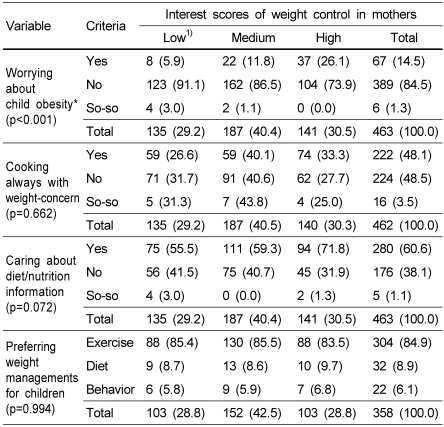





 PDF
PDF ePub
ePub Citation
Citation Print
Print



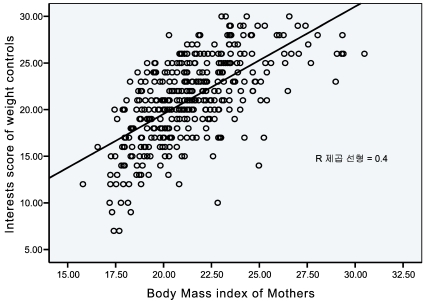
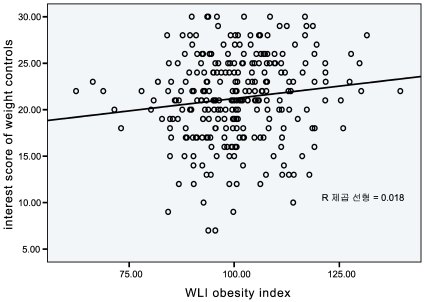
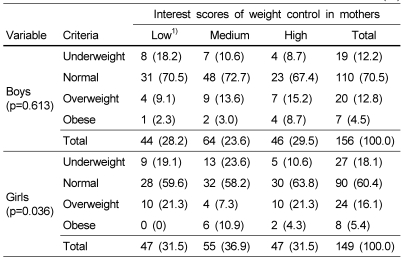
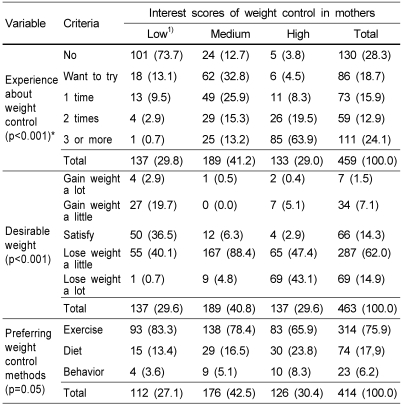
 XML Download
XML Download